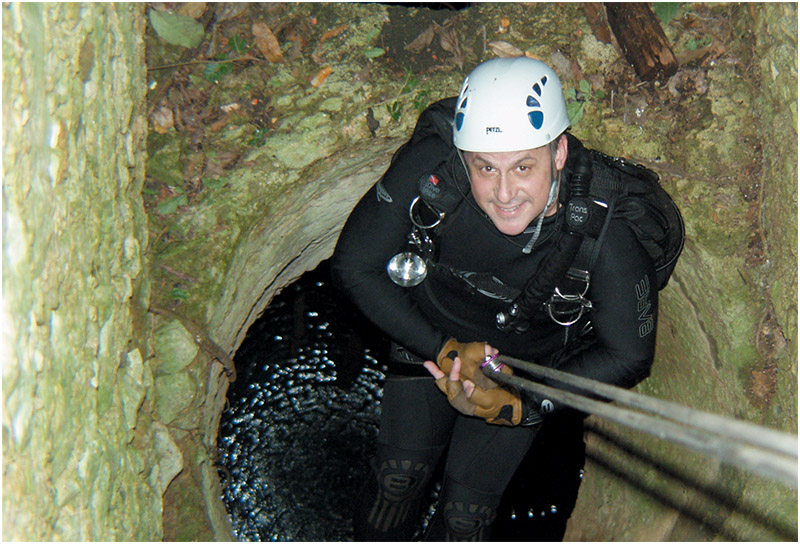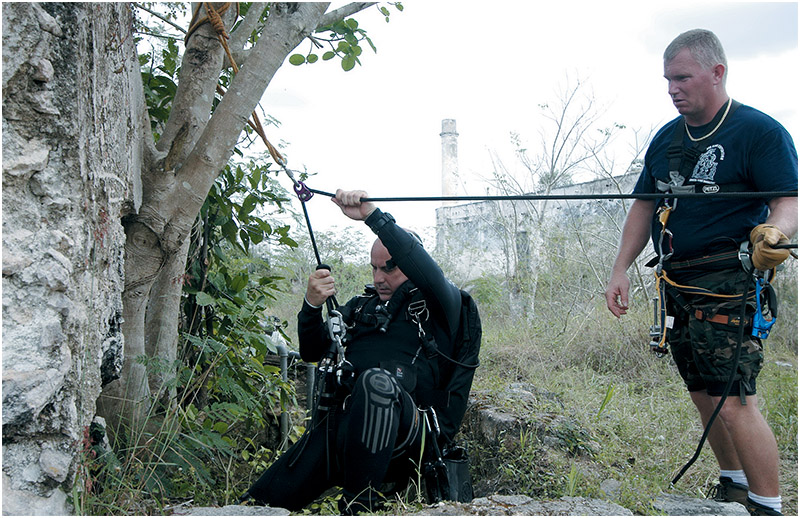

|
|
|
 |
| |
Sometimes on an expedition, there is less discovery and more exploration, as in we are constantly exploring the remote Yucatan jungle to discover a cenote, well, or cave to explore. That can mean a lot of time spent bouncing around on dirt roads or barely distinguishable paths.
Our first actual day of exploration proves somewhat disappointing. Explorer Rusty Farst drew the best assignment of the day, diving a virgin, corkscrew cave. (see image on the left) This would prove to be one of the two most significant dives of the expedition, both initially explored by Rusty.
The cave is positioned in the far corner of a walk-in cavern. It does not have a name that we can determine. The cavern is fascinating for our team of biologists who contented themselves identifying several small cave shrimp and one very impressive eyeless cave eel. |
|
| |
 |
Above: A small opening in the jungle leads the team of explorers to a large underground room containing a shallow water pool. |
|
|
|
| |
Rusty accessed the underwater portion of the cave through a relatively narrow horizontal opening in the dry cavern. The cave itself twisted down revealing a central column, but very little in the way of archaeological relics. It was obvious that the cavern and pool of water were popular with local residents, but that the underwater cave itself was unexplored.
Rusty saw only a single pot, a large urn that was cracked horizontally across the center but remained otherwise intact. He laid line on his 30-minute dive to a depth of 80 feet. From what he could see, the cave appeared to channel deeper, but as it is the first day and we have a great deal of ground to cover, we decide to leave it for further exploration at some future point. |
|
| |
 |
Above: Triple bell towers rise above the small village of Homun, Mexico. Homun is located just to the south east of Merida.
Below: Homun large Catholic church sits in the center of the village. |
|
|
|
 |
| |
We return to our home base in Homun where we are staying at the main Catholic Church, which we believe is around 400 years old. We spend the evening going over plans for the next day’s work. Team leader Curt Bowen has spent many tireless hours poring over previous expeditionary data as well as satellite information. He has discovered several ranches and haciendas to the east of a town called Soltuta. |
|
| |
 |
Above: Elmer (far right) is the Jedi Cenote Master and legend lover of the Yucatan. It is rumored that Elmer has over 90 children with family in every village throughout the Yucatan. Elmer is a water pump mechanic by trade and spends every day in local Ranchos fixing pumps that draw water from Cenotes for the farmer’s cattle. A key person to help gain access into private property, Elmer is worth every grande coke we pay him. Next to Elmer is team member Norma Garcia and just one of Emers possible children. |
|
|
|
| |
The Dogs Bark and the Rain Falls
We spent our first night in Homun serenaded by howling dogs. The fact is, dogs in Yucatan are not pets. There is no one to shush them, no animal control officer to phone; these feral dogs own the night, at least aurally. We sleep in hammocks inside the church. Some of us sling our hanging beds in rooms off the courtyard, others hang the hammocks in the roofed off area that is still essentially outside.
Axis Mundi
Caves played an important and spiritual role in Mayan culture according to team member and archaeologist Norma Garcia. She explains, “Axis Mundi translates roughly to ‘center of the world.’ The Mayans viewed caves in this way. “There were many rituals practiced in caves. For example, the men went into the cave, along with boys. The boys made sounds like frogs to ask the gods for water,” Norma explains. |
|
| |
 |
| |
In early afternoon, we find a large sinkhole. I am the designated explorer, donning my gear I carefully make my way down toward the water, taking care not to slip on loose rocks or the muddy path. There is a somewhat harrowing traverse over a makeshift railing someone installed a long time ago. The rickety trees used as uprights for the railing have roots exposed on the sheer face of a mud cliff. This may be the most dangerous part of this dive, just getting to the water without tumbling 50 feet into a jungle well.
A final safety check at the water’s edge, and I step into the dark water and begin my descent. The water is the color of coffee with a splash of cream. The muck continued to 45 feet. When it did clear up, there was still no visibility because of the dark water above. I went from coffee with cream to coffee black. But visibility and darkness were not really the problem, not by a long shot. After all, caves are always dark. The problem was that I was tangled in vines and the branches of fallen trees. The slightest touch and they release decades worth of fine particulate matter, quickly silting up the entire area and dramatically reducing the ability of my light to pierce the darkness. I quickly realize there is no chance of investigating this cenote.
We dubbed this hole “Jeff’s Dive of Black Death,” and headed back up the sheer cliffs to the waiting van |
|
| |
 |
Above: Cave explorer Jeff Toorish descends into a farmers well in search of cave passage or maya artifacts. |
|
|
|
| |
Sometimes exploration and discovery can be exciting.
The most memorable event of the day was a cenote down a 70-foot cliff (see illustration on below page). It was Matt’s turn to make the initial exploration. This particular sinkhole would require rigging climbing gear, and lowering Matt straight down in the water.
After rigging and safety instructions from Curt, Matt was lowered into the hole. Although relatively deep and pretty, it did not show much promise; but, with only a quick recon dive, one can easily miss something. So we marked this site for future exploration needed. |
|
| |
 |
Above: A strange sight for any passing cattle rancher, diver Matt Mandzieuk dresses in full side-mount and climbing equipment, makes his way through the Yucatan scrub jungle to be the first to explore the bottom of Cenote Cutzi.
Below: Artist’s rendition of what the exploration team observed within the depths of Cenote Cutzi. Maximum depth explored was 139 feet. |
|
|
|
 |
| |
The Myth of the Horse
The morning is misty; we rise early and get underway quickly today. Curt’s new strategy is to seek wells on haciendas and ranches. We have used various methods to find cenotes, including guides, satellite imagery, and ground level observation. Once we spot a likely candidate for exploration, the Quick Response Team jumps into action. The “team” is made up mostly of Rob Stewart who dashes through whatever jungle danger is present to drop a weighted line into a well, sometimes with a flashlight attached, to make the initial reconnaissance of the site. Rob, an open water diver, also swam some pools without scuba gear before Curt decided whether we would take the added time to send in an explorer.
In one very old town, we find a windmill high over a well on a farm. The farmer grants us permission to explore his well. Remarkably, most farmers and ranchers have never ventured into their wells, and they are often curious about what is inside.
This farmer tells us a story about a beautiful horse that fell into the well. The ghost of that horse is still in the depths, and tries to lure passers-by to the well’s edge. Once there, they will succumb to the siren song of the horse, causing them to fall into the well to their death. I’ll soon find out whether this myth is true because I will be exploring this well. |
|
| |
 |
Above: Remarkably, a horse skeleton is discovered in the cenote. Could this be the fabled white horse that’s siren song lured people to their deaths be true? The farmer face turned pale when we showed him the horse skeleton photo. |
|
|
|
| |
After gearing up and rigging for climbing, the team slowly lowered me down a 60-foot vertical tunnel. About 35 feet down, I had to shimmy past a tight obstruction before continuing on the rope descent. Dropping free of the well shaft, I found myself dangling in a large room with large stalagmites, stalactites, and columns. There was a debris pile in the center of the room. A few minutes later, the team lowered a single tank. I clipped it on and explored a pumpkin-shaped cave that pinched off at about 55 feet at its deepest. To my surprise on the slope of the mud bank lay the skeleton of a horse.
Retuning to the surface, I lock onto the rope and holler “on rope,” to the team above. Just as I feel the first tug of the line, I also hear what sounds like muted braying, a serenade of sorts, the myth of the horse? Stranger things have happened. It is becoming stronger now, more pronounced….
I Just in time, I climb out of the well, Rusty appears with a video camera for my report. I remind Rusty about the farmer’s warning, and tell him about the mysterious braying I heard while dangling on the rope. Could there be truth in the farmers warning? |
|
| |
 |
Above: An natural marker in the jungle. Large Bayan trees reach far above the Yucatan scrub jungle. These trees are hints of hidden Cenotes as they require tremendous amounts of water and are often found with their long roots streaching 100 plus feet below forming large root islands on the waters surface of large Jungle Cenotes. |
|
|
|
| |
Diving the Distillery
In Lazaro Carderas, a hacienda town, we have discovered what
appears to be one of the most promising wells of the trip. It is
located on the grounds of an abandoned distillery that apparently
made different types of liquor, including tequila. You can imagine the
jokes flying about what might be down that well (see illustration on
the left page).
Kim Smith will snorkel the well while explorer Matt Mandzieuk will make the initial dive. Matt discovers a large cave with human and animal remains at a depth of about 60 feet. The artifacts are mostly buried, and we strictly enforce the no-touch rule, but enough of the remains are visible to photograph. I gear up and head down the well, followed shortly by a tank and my underwater camera gear.
|
|
| |
 |
Above: Curt Bowen controls the ropes as explorer Jeff Toorish is lowered into Cenote Lazaro Carderas in order to photograph some discovered human remains.
Below: Artist’s rendition of Cenote Lazaro Carderas |
|
|
|
 |
| |
For this expedition, I am shooting with a Canon 20d camera with an Ikelite housing and Ikelite DS125 strobes attached with UltraLight arms. Behind the 8-inch dome port is a Canon 17-35 mm wide-angle zoom which gives me some flexibility.
The topside crew carefully lowers the housed camera down the 50-foot well. Matt deftly navigates us back to the artifacts. This is not the underwater equivalent of King Tut’s tomb, but considering the slim pickings on this expedition, we are grateful to have some news to bring back to the archaeologists. |
|
| |
 |
Above: ADM team member Norma Garcia prepares for another exploration dive into a virgin cenote.
Below: On Rope, Rusty Farst drops through a farmers well and into another pit. |
|
|
|
 |
| |
Barbed Wire and Bees
The first thing the team does when approaching a cenote, sinkhole, or well is to listen; specifically, listen for the distinctive buzzing of bees. More specifically, Africanized killer bees. The local Mayan residents call them abejas, pronounced bay’-haas. When they are present, the guides quietly say abejas, and everyone begins to leave quickly, making as little noise as possible. These bees are extremely aggressive, possess hunter instincts, and will swarm and attack in seconds. They post sentries at intervals from their hive and have elaborate communications apparatus.
At a hacienda in Lepam, we discovered several wells. Two were just holes in the ground, cordoned off with barbed wire fencing. We learned a young boy had fallen into one of the wells and drowned. His body had been recovered, but the residents had insisted that the well openings be blocked. |
|
| |
 |
Above: Life is hard in the Yucatan. An elderly Mayan lady stops to see what we are doing in her village.
Below: A "Libre Nacho" Tricycle is the common form of transportation in the Yucatan. Often used to transport people, food or fire wood. For the right amount of money, you can catch a ride through the village. |
|
|
|
 |
| |
The caretaker of the abandoned hacienda grounds gave us permission to dive the two wells behind the barbed wire curtain. Norma, already geared up, was eager to climb down. The rigging operation took a bit of doing, and we managed to divert some of the barbed wire to facilitate Norma getting to the opening. She locked onto the rope and began her descent into a very dark well. Without warning, abejas swarmed. With her accent we thought we heard her yelling “slow,” but in reality she was yelling “GO!” as in GO!GO!GO!
The swarm was stinging her, and Curt quickly dropped her the remaining distance to the water. His experience on rope allowed him to get her past the danger but still down safely. Normally, the bees will not follow someone into a well, and mercifully that was the case here. The well itself proved not worth the pain, and now we had the problem of getting her up and out, past a hive of angry, defensive bees.
The trick is to subdue them without incurring their wrath. After some consultation between the guides, a local man made an impromptu torch, set it alight and then used the smoke to neutralize the bees. It is an old method but effective. Of course, someone has to actually get up close and personal with the hive to smoke out the bees. In short order, Norma was out of the well, and we were packing up before the abejas realized we were gone.
Sometimes exploration and discovery can be painful. |
|
| |
 |
Above: Diver Robert Stewart assists with moving tanks down a rope for explorer Rusty Farst.
Below: Artistic rendition of Cenote Sabachen. Explorer Rusty Farst reports that the cave continues with a 100-foot wide passage at a depth of 140 feet. Continued exploration required! |
|
|
|
 |
The Diving Gods
We traveled about an hour to a town called Sivachee. Rusty is up
for the first dive of the day, which requires special rigging to move
the tanks into position. We use standard aluminum 80s, but the
configuration of this cavern means rigging a nearly horizontal zip line
to slide the tanks to the water
Rusty Farst must have paid some special homage to the diving gods, because once again he is diving into a very promising cave. Rusty reported that this cave is an offset sink and probably continues much deeper. This sink is definitely worth further exploration, and will prove to be one of the most significant discoveries of the expedition, more so than the cave at the distillery.
|
|
| |
 |
Above and below: We often stumble upon old cemeteries lost in the jungle. In this area, the dead where buried in shallow graves just to be dug back up and their bones placed in small rock houses. Forgotten, this cemetery has fallen into serious decay exposing the bones within. |
|
|
|
 |
| |
Not All Exploration Leads To Discovery
Several team members are sick, reducing our numbers and ability to explore. We realize this expedition is drawing to a close, and we have not yet discovered a truly stand-out cave. Nevertheless, the Yucatan 2007 Expedition was memorable for several reasons. We have found a few caves with some potential, and subsequent trips may well reveal their secrets. We can mark off this area as being explored to a reasonable extent. And perhaps most fulfilling, we see and photograph a part of Mexico that is not in the tourist guides, a mystery to most North Americans.
As with all Advanced Diver Magazine expeditions, one of our goals is to document the discoveries as well as the natural and man-made environments where they are located by recording data sheets, video, and thousands of
still images.
|
|
| |
 |
|
| |
|